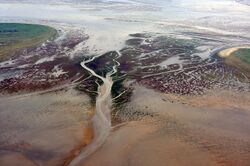Earth:Creek (tidal)

A tidal creek, tidal channel, or estuary is the portion of a stream that is affected by ebb and flow of ocean tides, in the case that the subject stream discharges to an ocean, sea or strait. Thus this portion of the stream has variable salinity and electrical conductivity over the tidal cycle, and flushes salts from inland soils. Tidal creeks are characterized by slow water velocity resulting in buildup of fine, organic sediment in wetlands. Creeks may often dry to a muddy channel with little or no flow at low tide, but with significant depth of water at high tide. Due to the temporal variability of water quality parameters within the tidally influenced zone, there are unique biota associated with tidal creeks which are often specialised to such zones. Nutrients and organic matter are delivered downstream to habitats normally lacking these, while the creeks also provide access to inland habitat for salt-water organisms.[1]thumb|Aerial photo of North Sea, tidal inlets from the Wadden Sea on Scharhörn
Names
In British English and in many other countries in the Commonwealth, such as The Bahamas, as well as some parts of the United States (near the Chesapeake Bay, parts of New England,[2] and southern Florida[lower-alpha 1]), a creek is a tidal water channel. In the tidal section of the River Thames in London, the names of the rivers that flow into it all become Creeks for the lower section that is tidal; thus, for example the River Lea becomes Bow Creek in its tidal section. In parts of southwest England and Wales, the term 'pill' is used,[4] and is found in placenames such as Huntspill.
On the India and Pakistan borders the term also applies to the salt water inlets enclosed by mangroves. Creeks are found dispersed all along the Indian coast.
Development
Whereas areas of coastline that experience high wave activity are usually characterized by beaches, areas sheltered from wave action may develop tidal wetland systems. In these areas, creeks form to drain the high part of the coast. They are often very sinuous, and form by headwater retreat and downward incision of the water as it flows from inland to the shore. Tidal creeks deposit sediment in a process called accretion, which can maintain a flat plain by counteracting sea level rise or land subsidence. High tidal flow will maintain channels, while slower flow velocity can lead to closure of tidal creeks as they become clogged with sediment. Well-developed wetlands have sharp-banked tidal creeks, with vegetation stabilizing the sides of the creeks. Such tidal creeks will also be connected in networks: a multitude of smaller creeks called first-order creeks will feed into large ones, creating complex patterns of drainage.
Human impact
Especially in areas prone to compaction or subsidence - like peat wetlands - human use of tidal creek flow can lead to the expansion of the creeks. Natural subsidence is compounded by anthropogenic sediment compaction, lowering the land level. Deforestation and other human-development-related processes can destabilize the banks of creeks and increase the amount of sediment in them. This slows the velocity of the water, which means that instead of cutting deeper channels the water flows gently farther inland in shallow channels.[5] Human development in tidal areas often results in diking, which changes the course of the tidal creeks and the salinity of the tidal area into freshwater.[6]
Restoration of tidal wetlands begins with restoration of the creek systems, which determine the shape of the land, the nutrient and salinity levels, and the type of vegetation and animal communities in a wetland.[6][7][8]
Examples
There are thousands of examples of tidal creeks throughout the world. A few specific ones are:
- Burn of Ayreland, Mainland, Orkney
- Americano Creek, California, USA
- Crooked River, Florida, USA, a 41-kilometre (25 mi)-long tidal channel connecting two estuaries
- Ennore creek, Chennai, India
- Thane Creek, Mumbai Metropolitan Region, Maharashtra, India
- Gorai Creek, Mumbai, Maharashtra, India
- Vasai Creek, Thane, Maharashtra, India
- Dubai Creek, United Arab Emirates
See also
- River delta
- Salt marsh
- Tidal course
Footnotes
References
- ↑ Zedler, Joy B., ed (2001). "Hydrology and Substrate". Handbook for Restoring Tidal Wetlands. CRC Press.
- ↑ "About the Spruce Creek Watershed". Archived from the original on 2008-07-03. https://web.archive.org/web/20080703211312/http://www.sprucecreekassociation.org/sprucecreek.html. Retrieved 2009-06-15.
- ↑ "Terra Ceia Aquatic Preserve -DEP-staff-Randy-Runnels-Frog-Creek | Florida Department of Environmental Protection". https://floridadep.gov/fco/nerr-rookery-bay/media/terra-ceia-aquatic-preserve-dep-staff-randy-runnels-frog-creek.
- ↑ The Compact Edition of the Oxford English Dictionary. II (P–Z). Oxford University Press. 1971. pp. 2174.
- ↑ Pierik, Harm Jan; Stouthamer, Esther; Schuring, Tim; Cohen, Kim M. (2018-09-25). "Human-caused avulsion in the Rhine-Meuse delta before historic embankment (The Netherlands)" (in en). Geology 46 (11): 935–938. doi:10.1130/g45188.1. ISSN 0091-7613. Bibcode: 2018Geo....46..935P.
- ↑ 6.0 6.1 Karberg, Jennifer M.; Beattie, Karen C.; O’Dell, Danielle I.; Omand, Kelly A. (2018-06-18). "Tidal Hydrology and Salinity Drives Salt Marsh Vegetation Restoration and Phragmites australis Control in New England" (in en). Wetlands 38 (5): 993–1003. doi:10.1007/s13157-018-1051-4. ISSN 0277-5212.
- ↑ Isdell, Robert E.; Bilkovic, Donna M.; Hershner, Carl (2018). "Shorescape-level factors drive distribution and condition of a salt marsh facilitator (Geukensia demissa)" (in en). Ecosphere 9 (10): e02449. doi:10.1002/ecs2.2449. ISSN 2150-8925. https://scholarworks.wm.edu/cgi/viewcontent.cgi?article=1704&context=vimsarticles.
- ↑ Li, Runxiang; Yu, Qian; Wang, Yunwei; Wang, Zheng Bing; Gao, Shu; Flemming, Burg (2018). "The relationship between inundation duration and Spartina alterniflora growth along the Jiangsu coast, China". Estuarine, Coastal and Shelf Science 213: 305–313. doi:10.1016/j.ecss.2018.08.027. ISSN 0272-7714. Bibcode: 2018ECSS..213..305L.
